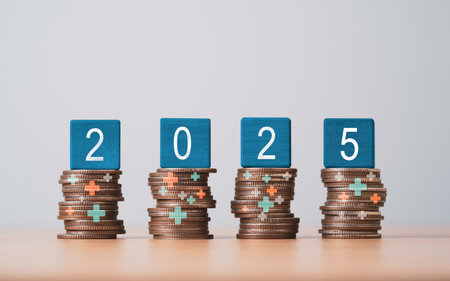Introduction to Budgeting Apps
In today’s fast-paced American lifestyle, managing personal finances has become more complex than ever. From juggling multiple subscriptions and student loans to keeping tabs on daily expenses, many individuals find it challenging to maintain a clear financial overview. That’s where budgeting apps come into play. These digital tools have rapidly gained popularity across the U.S., empowering users to take control of their money with convenience and accuracy. By linking directly to your bank accounts, credit cards, and even investment portfolios, budgeting apps automate much of the tracking and categorization process, making it easier for you to visualize spending patterns, set savings goals, and avoid unnecessary debt. Whether you’re aiming to build an emergency fund, pay off credit card balances, or simply get a better handle on your monthly cash flow, the right budgeting app can be a game-changer. This article will break down the leading options in the market, helping you decide which solution aligns best with your unique financial needs and lifestyle.
2. Key Criteria for Evaluating Budgeting Apps
When choosing a budgeting app, it’s essential to focus on features that truly impact your financial management experience. Whether you’re a college student trying to control spending or a professional looking to optimize investments, here are the key criteria you should keep in mind:
Ease of Use
The best budgeting apps offer intuitive interfaces and simple navigation. An overly complex app can be discouraging, while one that is user-friendly encourages consistent use and better financial habits.
Security
Your financial data is sensitive. Look for apps with robust encryption, two-factor authentication, and transparent privacy policies. This ensures your personal and banking information stays protected from unauthorized access.
Syncing Bank Accounts
Automatic syncing with your bank accounts saves you from manual entries and reduces errors. The ability to connect multiple accounts (checking, savings, credit cards, loans) in real time provides a holistic view of your finances.
Automation
Automation features—like automatic transaction categorization or recurring bill reminders—can save you time and help you stick to your budget without constant oversight.
Reporting Capabilities
Detailed reports and visual dashboards allow you to analyze spending trends, set goals, and track progress over time. Look for apps that break down expenses by category and offer customizable reports.
Feature Comparison Table
| Feature | Why It Matters | What to Look For |
|---|---|---|
| Ease of Use | Makes budgeting sustainable long-term | Simple setup, clear navigation, mobile-friendly design |
| Security | Keeps financial data safe | Encryption, 2FA, strong privacy policy |
| Syncing Accounts | Saves time & avoids manual errors | Support for major US banks & credit cards, real-time sync |
| Automation | Reduces repetitive tasks & missed bills | Auto-categorization, recurring reminders, goal automation |
| Reporting Capabilities | Makes insights actionable for better decisions | Customizable charts, export options, category tracking |
Selecting an app that scores high on these criteria will give you a solid foundation for managing your money efficiently—and ultimately help you reach your financial goals faster.
![]()
3. Top Budgeting Apps Reviewed
When it comes to personal finance management, Americans have several high-profile budgeting apps to choose from. Let’s break down the features, strengths, pricing models, and user experiences of four leading apps: Mint, YNAB (You Need A Budget), EveryDollar, and Personal Capital.
Mint
Strengths
Mint is widely recognized for its comprehensive money tracking capabilities. It automatically syncs with your bank accounts, credit cards, and bills, offering a real-time overview of your finances. Its robust alert system notifies users about upcoming bills, suspicious transactions, and budget limits.
Pricing
Mint is free to use, making it especially attractive for budget-conscious users. However, it does feature ads and product offers within the platform.
User Experience
The app’s intuitive dashboard makes navigation simple for beginners, though some advanced users may find its reporting tools somewhat limited compared to more specialized platforms.
YNAB (You Need A Budget)
Strengths
YNAB takes a proactive approach by encouraging users to allocate every dollar to a specific purpose. This zero-based budgeting method is ideal for people who want complete control over their spending habits and are serious about long-term financial transformation.
Pricing
YNAB charges $14.99 per month or $99 annually after a 34-day free trial. While it’s one of the pricier options, many users report significant savings as a result of its methodology.
User Experience
The learning curve can be steep for newcomers, but YNAB’s educational resources and supportive community help smooth the transition. Its mobile and web apps are both highly rated for reliability and design.
EveryDollar
Strengths
Built on Dave Ramsey’s popular budgeting principles, EveryDollar focuses on simplicity and ease of use. Users can quickly set up monthly budgets and track spending manually or automatically (with the paid version).
Pricing
The basic version is free; EveryDollar Plus—which adds automatic bank syncing—costs $79.99 per year after a 14-day free trial.
User Experience
The app stands out for its clean interface and straightforward workflow. It’s especially well-suited for those following the “baby steps” philosophy or new to budgeting altogether.
Personal Capital
Strengths
Personal Capital combines budgeting with powerful investment tracking tools. In addition to expense tracking and cash flow management, users get access to detailed net worth analysis and retirement planning calculators—a unique value proposition for those interested in both budgeting and wealth-building.
Pricing
The core app is free, while advanced wealth management services are available at a fee based on assets under management.
User Experience
The interface is polished and data-rich, catering to users who want a holistic view of their financial life beyond everyday budgeting. The investment tools make it stand out among pure budgeting apps.
Summary Table: Key Differences
- Mint: Best for all-in-one money management at no cost
- YNAB: Ideal for disciplined budgeters seeking behavioral change
- EveryDollar: Perfect for fans of Dave Ramsey or simple budgets
- Personal Capital: Designed for those wanting both budgeting and investment oversight
This detailed comparison highlights that the “best” app depends on your specific financial goals, habits, and willingness to pay for extra features or guidance.
4. Pros and Cons of Each App
Choosing the right budgeting app depends on your financial goals, tech comfort level, and desired features. Here’s a detailed breakdown of the advantages and downsides of the most popular budgeting apps in the U.S., so you can pinpoint which option fits your lifestyle best.
| App Name | Pros | Cons | Best For |
|---|---|---|---|
| Mint | – Free to use – Automatic account syncing – User-friendly interface – Comprehensive bill tracking |
– Ads can be intrusive – Limited customization – Customer support can be slow |
Beginners looking for an all-in-one, free solution with automated tools |
| You Need A Budget (YNAB) | – Hands-on zero-based budgeting method – Strong educational resources – Proactive goal-setting features – No ads |
– $14.99/month or $99/year after trial – Steeper learning curve – Requires active involvement |
Users committed to proactive money management and willing to pay for advanced tools |
| PocketGuard | – Easy setup and automation – Shows “In My Pocket” funds clearly – Useful for reducing overspending – Free basic version available |
– Limited customization on free tier – Fewer investment tracking options – Some features require paid plan |
People who want a quick snapshot of spendable cash without fussing over details |
| EveryDollar | – Simple, intuitive layout – Dave Ramsey-endorsed zero-based budgeting – Fast manual entry for transactions – Syncs with bank accounts (paid version) |
– Manual entry required on free plan – Bank sync only in paid version ($12.99/month) – Fewer reporting features compared to competitors |
Fans of Dave Ramsey’s philosophy and those new to budgeting wanting simplicity over complexity |
| Goodbudget | – Envelope system visualized digitally – Shared budgets for couples/families – Cross-platform access (iOS, Android, web) |
– Manual transaction input can be tedious – Less automation than competitors – Advanced features behind paywall ($8/month) |
Couples or families managing shared finances who prefer envelope-style allocation |
Key Takeaways for Choosing Your App
While Mint offers robust automation for beginners, YNAB excels for disciplined budgeters ready to invest time and money into their financial health. PocketGuard is best for straightforward spenders focused on avoiding overdrafts. EveryDollar brings zero-based budgeting to the forefront but may require more manual effort unless you upgrade. Goodbudget is ideal for those who want a modern take on envelope budgeting, especially when collaborating with others. Understanding these pros and cons will help you align each app’s strengths with your unique needs.
5. Which Budgeting App Fits Your Financial Lifestyle?
Selecting the ideal budgeting app comes down to understanding your unique financial habits, goals, and the features you value most. Here’s a breakdown of how to match the top budgeting apps with your personal finance style:
Budgeting Habits
If you’re a hands-on budgeter who likes to track every dollar, apps like You Need a Budget (YNAB) offer detailed envelope-style budgeting and real-time transaction syncing. For those who prefer a more automated approach, Mint excels at categorizing expenses and providing an overview with minimal manual input.
Financial Goals
Your financial objectives should drive your app choice. If debt payoff is your main focus, look for apps that prioritize debt tracking and repayment planning, such as EveryDollar. For users building savings or investment portfolios, tools like Personal Capital combine budgeting with wealth management features, giving you a holistic view of your net worth.
Preferred Features
Consider which features are must-haves for your daily money management. Do you want bill reminders, credit score monitoring, or custom spending categories? Apps like Mint provide comprehensive alerts and insights, while YNAB offers goal tracking and education-driven support. Those seeking data privacy may prefer apps that keep information on-device rather than in the cloud.
User Experience & Integration
An intuitive interface can make or break your commitment to budgeting. Evaluate whether you prefer a mobile-first design or robust desktop options. Also, check compatibility with your bank and other financial accounts for seamless integration—most leading apps support major U.S. institutions but may differ in depth of connection.
The best app is ultimately the one that aligns with both your current lifestyle and long-term financial ambitions. Test out free trials where available and assess how each platform supports your journey toward smarter spending and saving.
6. Final Thoughts and Next Steps
Choosing the right budgeting app is a crucial first step toward achieving your financial goals. As we’ve compared the leading options on the market, including apps tailored for simplicity, automation, or deep analytics, it’s clear that no single solution fits everyone. The best budgeting app for you depends on your specific financial habits, preferred features, and comfort with technology. Key takeaways from our comparison include: user interface matters for day-to-day tracking, customizable categories help tailor budgets to your lifestyle, and integration with your banks and credit cards can save time while improving accuracy. Security and privacy should also be top priorities when choosing an app.
Now that you’re equipped with this knowledge, consider your most important needs—is it automated syncing, detailed reporting, or collaborative household budgeting? Most of these apps offer free trials or starter versions, so don’t hesitate to test a couple before committing long-term. Starting your budgeting journey with the right tool can make all the difference in sticking to your plan and building healthy financial habits. Remember, the best budgeting app is the one you’ll actually use. Take action today by downloading an app that matches your preferences and begin tracking your spending—your future self will thank you.


